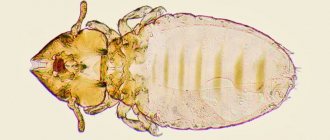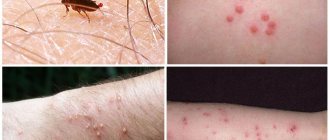Many people think that ticks can only bite a person or a dog, without posing a danger to the cat family. This is not true; according to statistics, cats suffer from tick bites and develop complications much less frequently, but the course of the disease, diagnosis and treatment are more difficult. Even domestic cats require special attention, since the parasite can enter the house through shoes or on human clothing.
Ticks are especially active from March to November; they can be found in grass or bushes, in city parks, and forests. Parasites pose a danger to walking animals, but even if the animal does not leave the house or apartment, the risk of finding a parasite in a cat is not so small.
Subcutaneous mites in cats (demodex): what is it?
In domestic animals, askariasis is caused by different types of parasites. But the most commonly diagnosed is demodicosis - a chronic disease caused by Demodex cati and Demodex gatoi.
The arthropod is localized in the hair follicle, sweat (epocrine) and salivary glands. Larvae hatch from oocytes laid by females on days 4-6. After 7-10 days, individuals ready for reproduction grow. Pathogenic microorganisms live in colonies, forming painful nodules on the body of predators. Enlarged colonies cause atrophy of the sebaceous glands and disruption of skin functions.
There are two types of demodicosis: generalized and localized. The latter is characterized by damage to certain areas of the body: ears, eyes, chin and neck. Generalized spreads throughout the skin. This form is common in purebred Siamese and Burmese breeds.
How does infection occur?
The tick is transmitted through saliva, fur, and microtraumas when a sick animal comes into contact with a healthy one.
Infection will occur only if the animal’s immune system is weakened, its metabolism is impaired, i.e. it is at risk, and this is:
- pregnant cats;
- old individuals;
- animals with chronic diseases;
- kittens.
Kittens can become infected from their mother. The tick can also be transmitted through common hygiene products that the cat comes into contact with.
If the cat has a strong immune system, it can become a carrier of the pathogen: it will not get sick, but it can transmit it to other animals.
Causes of subcutaneous mites in cats
Ticks are part of animal life. Some live in hair follicles for years, feeding on dead epithelial cells. The predator's immune system controls the parasite population. If the pet is weakened, the body's protective functions reduce the ability to regulate the number of arachnids. Arthropods multiply rapidly, attacking healthy cells.
Factors influencing weakened immunity:
- helminthic infestations;
- hereditary or chronic diseases;
- unbalanced diet, lack of vitamins and minerals;
- improper maintenance and care (dirty litter);
- rare or lack of water procedures using antiparasitic agents.
Stress also reduces the body's protective functions.
Treatment
Treatment of demodicosis caused by subcutaneous mites is a long and difficult process. Its complexity is that often this disease develops against the background of a decrease in the body’s defenses and has accompanying skin problems. Therapy tactics include suppressing the parasite, treating underlying diseases and increasing immunity.
The most commonly used local therapy is lotions and special ointments. In more severe cases, the doctor prescribes a course of antibiotics in combination with external therapy. Sometimes plasmapheresis procedures are recommended. In special cases, even surgical intervention is possible.
An important point in the course of treatment is diet. It is necessary to exclude hot, spicy and salty foods, foods rich in carbohydrates and fats from the diet. Those who are being treated for subcutaneous mite infestation are recommended to consume large amounts of fruits, vegetables, microelements, fiber, and dairy products. During treatment, you should not use face masks, especially those containing honey. You need to limit your exposure to the sun. You should also wait until better times to visit the bathhouse and sauna.
Subcutaneous mites in cats: routes of infection
Infection of a healthy predator occurs through direct or indirect contact with a sick one. Parasites are spread by using a shared brush to comb out wool and bedding. Microorganisms enter the apartment with clothing when a person comes into contact with an animal affected by arthropods.
Be sure to read:
How many days before vaccination should a cat be given anthelmintic: why, how to do it correctly, the best remedies
Routes of infection:
- direct contact with a sick predator;
- contact with the fur of a predator affected by demodicosis;
- intrauterine.
If a breeder has several pets, therapeutic measures are applied to all of them without exception.
Can a cat die from a tick bite?
Are ticks dangerous for cats? The parasite itself does not pose a danger to the animal if it is not the causative agent of any disease.
Can a cat die from a tick bite? With timely treatment and treatment, the animal’s health is restored without complications. If urgent measures are not taken, the animal’s body weakens in a matter of time, exhaustion and disruption of the functioning of internal organs are observed, which leads to serious consequences, including death.
Animal risk group
Parasitic arachnids affect all predators, regardless of breed, sex, or age. A healthy pet with a strong immune system is not in danger. Under such conditions, the animal and arthropods are in an antagonistic relationship, where the cat’s body slows down the growth of parasitic microorganisms.
The following groups are susceptible to demodicosis:
- young individuals, especially those separated from their mother early;
- affected by leukemia and immunodeficiency viruses;
- with diagnosed immunosuppressive diseases (diabetes mellitus, toxoplasmosis);
- animals in the postoperative period;
- young offspring during the period of change of milk teeth to molars (4-6 months);
- exhausted after fasting;
- patients with rickets.
Stress caused by moving and frequent visits to the groomer negatively affects the health of the pet. The risk of ascariasis increases.
Consequences of a bite
Are ticks dangerous for cats? The parasite's bite itself does not threaten the health of the pet; the danger lies in the pathogens that can get from it to the animal through the bite. The Ixodid tick can cause the development of diseases such as piroplasmosis, hemorrhagic fever, typhus and encephalitis, and borreliosis.
If treatment is not started on time, the infection can affect many body systems and internal organs of your furry friend.
If a cat is bitten by a tick, the consequences, symptoms and treatment depend on the type of infection. Some diseases only affect the cat’s immune system, it becomes lethargic and apathetic, but treatment in this case is 95% effective. Other diseases may not respond to treatment and lead to the death of the pet.
Subcutaneous mite symptoms in cats
The clinical picture is specific. An increased number of parasitic microorganisms causes itching. First, there is increased hair loss, as if molting. Patchy bald patches of regular oval shape appear. In areas of alopecia, the skin is intensely red and covered with ulcers. Secondary staphylococcal infectious pathologies are added. The area around the eyes, under the neck, and front paws is most often affected.
Summary symptoms:
- hair loss;
- “demodectic glasses” - lack of hair around the eyes;
- inflammation, redness of the skin, swelling;
- skin pustules, ulcers;
- unkemptness, foul odor;
- the bites cause itching, the predator scratches the ear area until it bleeds;
- lack of appetite;
- weight loss.
In the generalized form, sepsis develops. Sometimes pets recover without treatment, but only with a localized form.
Preventive methods of controlling parasites
It is better to prevent any disease than to treat it, but it is impossible to isolate yourself from the whole world. Even if your pussy sits at home, you can infect it by bringing mites on your clothes or the soles of your shoes. Compliance with preventive measures includes:
- Minimizing contact with stray animals;
- Balanced nutrition for the pet - dry food should be at least premium, and homemade food only from high-quality products;
- Regular examination of the animal's fur and skin - first of all, the groin area, ears, armpits;
- Maintaining hygiene - cleaning bowls, toys and beds.
- Cat breeders should not separate kittens from their mother for up to two months - along with milk, the offspring receive passive immunity, which protects the animal from pathogenic organisms.
It is advisable to sterilize pets who have recovered from the disease in order to avoid hormonal imbalances, complicated by relapses in the future. If a cat is carrying kittens and at the same time has contracted scabies, there is a possibility of giving birth to offspring with pathologies. Compliance with hygiene rules and basic prevention will reduce the risk of infection for your pet.
What does a subcutaneous mite look like in cats?
Demodexes are very small and can only be seen under a microscope. They are worm-shaped. An adult male is 182 microns long, 20 microns wide, a female is 220 microns long, about 30 microns wide. Arachnids are gray in color.
The cephalothorax and abdomen are fused. The prosoma has 4 pairs of short legs, each of which consists of three segments ending in claws. The proboscis is well developed.
Be sure to read:
When to worm kittens for the first time: for what, at what age is it better, how to do it correctly, the best drugs
Can a person become infected from an animal?
It is not difficult to understand the concern of owners about whether ear mites can be transmitted to humans, because among animal diseases there are those that are transmitted to people, so it is quite natural to want to protect yourself and your loved ones, especially children, from danger.
The misconception that ear mites in cats are contagious to humans is common. Fortunately, there is no need to worry about this - it is not transmitted to humans. Some other types of ear mites are occasionally found in humans - mostly, they are brought by tourists from hot exotic countries, but cats are not infected with such mites either, they only infect humans. One type of parasite that affects both domestic animals and humans is the scabies mite.
© shutterstock
There is not a single case reported in the world where ear mites in cats are transmitted to humans. However, cat mites can still cause some health problems. First of all, it can cause allergies in a person who has a predisposition to it.
Treatment of subcutaneous mites in cats
At the first symptoms, your furry friend should be taken to the veterinary clinic. Only a doctor can make an accurate diagnosis.
Local therapy of uncomplicated forms:
- To eliminate exudate, dead epithelium, and dandruff, your furry friend is bathed with shampoos containing antiseptics (benzoyl peroxide).
- The area around the wounds is treated with Mitaban solution. For localized demodicosis, a 0.25% solution is used, for generalized demodicosis without complications - 0.5%. In generalized forms with pyodemodecosis and staphylocosis, 1% working concentration of the drug is used for treatment.
- The use of Advocate drops is indicated for therapeutic and preventive purposes. Using a pipette, the drug is applied to dry, intact skin in places inaccessible for licking (between the shoulder blades) at the rate of 0.1 ml per kg.
- Use topical medications containing pyrethrin or amitraz (Advantix, Prak-tik, Advantage). The regimen and dosage are calculated in accordance with the recommendations in the instructions or as prescribed by the veterinarian.
- To relieve inflammation, ointments (sulfur, Avexectin, Saproderm) and gels (Demox, Amidel, Ivermit) are prescribed.
During therapy at home, it is important to follow the dosage prescribed by your doctor. Exceeding concentrations can harm the health of your four-legged friend.
What to do at home if you are bitten
If the bloodsucker has not burrowed into the pet’s skin and it is found on the fur or in the place where the cat sleeps, then it is necessary to inspect the skin. Using a comb, you need to comb the animal against the fur, push it apart with your hands and inspect the skin. Favorite places for parasites to invade are the armpits, hind legs, stomach and groin. If a bite is detected, it is necessary to treat the wound or take it to a veterinary hospital; you should monitor the cat’s health for several weeks; if deterioration occurs, you should consult a doctor.
You can get rid of the parasite as follows:
- Wear gloves on your hands, and upon completion of all manipulations, carefully perform hygiene.
- To prevent the infection from spreading faster, do not lubricate the area around the tick with oil.
- You should not pull the parasite, this will lead to further penetration of the insect's head and the spread of infection.
- The tick must be removed completely without damaging it.
- You can remove the insect using thread or tweezers. You should grab the body of the parasite and pull it out gently and without sudden movements.
- If, however, part of the tick’s head remains in the skin, there is no need to worry too much, since the cat’s body can independently reject the remaining body. This often leads to the development of a small abscess, which can be prevented by contacting a veterinarian.
Treatment is prescribed only by a veterinarian based on the test results and existing symptoms; usually, antibiotic therapy cannot be avoided. You are allowed to treat the bite site yourself at home using antiseptic drugs, with the exception of iodine and brilliant green.
Drugs and medications
Localized forms with complications and generalized forms are treated comprehensively. Medicines are selected individually, taking into account concomitant diseases and the condition of the predator.
In case of infection with D. cati and D. gatoi, use the following treatment regimen:
- Amitraz 0.25%. The oil solution is applied to the affected areas once a day every 3 days. Course 4-6 weeks.
- Invec spray is applied to the affected areas. Treat 2-4 times with an interval of 3-5 days.
- Doramectin orally once a day at a dosage of 40-60 mg per kg of body weight. Therapy is carried out for no more than a month.
- Antiparasitic drugs for parenteral administration (s.c.): Dectomax, Baymek, Cydectin.
- Antibacterial drugs Betamox (active ingredient amoxicillin), Kanamycin (amikacin), Ciprovet drops (ciprofloxacin).
Since the fundamental ethological factor is weakened immunity, biogenic stimulants are prescribed: Gamavit, Baksin.
Signs of illness
In its manifestations, damage to the subcutaneous mite is very similar to rosacea or acne. Peeling of the skin and its redness are noted, itching may occur, constant or worsening after using tonics or washing with cold water. Sometimes there is a combination of demodicosis caused by subcutaneous mites and the above-mentioned skin diseases. And this is not surprising, because the occurrence of demodicosis is influenced by negative changes in the skin. Thus, both acne vulgaris and rosacea weaken the skin’s natural defenses. When affected by skin mites, the following parts of the face are most often affected: eyelids, forehead, chin, nasolabial folds and brow ridges. Exacerbations of demodicosis occur in autumn and spring.
Folk remedies
In parallel with traditional ones, alternative methods of therapy are used. folk recipes against askariasis:
- Infusion of leather mackerel. 1 tablespoon of dry herb is poured into about 5 liters of boiling water and set aside until it cools completely. The strained solution is diluted with 0.5 liters of water and the pet is bathed. The plant has a bactericidal effect and promotes rapid healing of wounds.
- Wounds are treated with calendula tincture. To avoid side effects, it is better to buy the product at a pharmacy and use it according to the instructions.
- Treatment of wounds with concentrated chamomile infusion. To prepare it, 100 dry plants are poured with boiling water. The cooled infusion is filtered.
Be sure to read:
How to deworm a cat: when to do it, how often, the best drugs and folk remedies
It is forbidden to treat leather with kerosene. The substance causes severe intoxication.
Prevention of demodicosis in cats
The basis of prevention is strengthening the immune system and preventing diseases that contribute to the development of askariasis:
- Organization of adequate nutrition and proper care.
- Weekly treatment of the pet's bedding, tray, and bowls with disinfectants.
- Regular prevention of ectoparasites (fleas, lice eaters) and endoparasites (tapeworms, nematodes) using tablets and sprays.
- Wearing Multi-X anti-parasitic collars.
- It is recommended to sterilize a female who has suffered a generalized form.
If the animal has received therapy for demodicosis, the pet is taken to the clinic every 6 months for the first 3 years to monitor relapse.
Are animal scabies mites dangerous for humans?
The causative agent of scabies is the itch mite, invisible to the ordinary eye. This highly contagious disease affects not only people, but also pets, including cats.
Owners who let their pets roam freely often wonder whether it is possible to get scabies from an animal.
This disease is not so common in four-legged murks, but owners should know the peculiarities of the disease and how it differs from the human species.
How does scabies appear in cats?
Invasive scabies infection in the cat family is fundamentally different from the human disease caused by a parasitic mite.
An accurate diagnosis can only be made by a veterinarian based on a visual examination of the animal and the results of skin scraping analysis.
The specialist will determine the type of scabies parasite, explain safety measures for the owner and prescribe treatment for the pet. There are three types of ticks in cats:
- Cheyletiellosis (scientific name Cheyletiella) - can be transmitted to humans, lives on the entire surface of the animal’s body.
- Notoedres - starts in the head area, provokes the formation of purulent crusts and hair loss. Can be transmitted to humans.
- Red-bodied tick (Trombicula) - chooses to live on the hind limbs of the body of cats, and can also be transmitted to humans.
In the initial stage, scabies appears in the neck, head and ears of the pet. Over time, the parasites spread over the entire surface of the animal’s body and lay eggs. In this regard, the aching itch worries the pet more and more, scratches and wounds appear on the skin, and the hair in these places falls out. In cats, scabies is accompanied by the following symptoms:
- increased anxiety and nervousness;
- refusal of usual food and water;
- aggressive behavior for no apparent reason;
- severe itching and increased scratching;
- hair loss;
- the appearance of purulent scratches on the surface of the skin.
If timely assistance is not provided, the disease progresses and the animal’s general condition becomes noticeably worse. Individuals with reduced immunity who have undergone a serious illness or surgery are at greater risk. In such cases, scabies may appear again and be more severe.
Diagnosis and treatment
To accurately determine the type of tick, a specialist must scrape it and send it for analysis. This is done in order to exclude diseases with similar symptoms - eczema, allergies, dermatitis or lichen.
Drug therapy for a four-legged patient lasts on average from one to three weeks. Special shampoos, sprays, ointments, as well as oral medications of various forms (drops, syrups, tablets) are used as treatment.
The approximate treatment formula looks like this:
- treating the affected surface with a gentle antiseptic - hydrogen peroxide, miramistin, chlorhexidine;
- taking antibiotics to prevent the risk of developing a secondary infection;
- use of acaricides to control insects;
- taking antihistamines to relieve itching;
- stimulating the work of immune cells with the help of vitamin complexes.
Particular attention should be paid to antiparasitic treatment. The dosage and drug should be determined by the doctor, taking into account the health characteristics of a particular animal. The effectiveness of the prescribed therapy will depend on the accuracy of the procedures recommended by the specialist. Even skipping a medication once will delay the healing process indefinitely.
How is scabies transmitted to humans?
For infection from a sick animal, ordinary contact is sufficient. For example, a child who pets a stray animal on the street becomes a carrier of scabies mites. Infection can also occur if a free-ranging pet brings parasites home. However, not all types of cat scabies are dangerous to humans, among them:
- Hair mites are able to survive exclusively in animal fur; human skin is not suitable for their life and reproduction.
- Parasites that can live on the human body for no more than two days - in this way, insects only move long distances and, not finding a more suitable host, die.
- Small mites that appear during the period when the cat’s immune system is weakened are relatively harmless to a healthy person.
In medical circles, there is a special term that characterizes infection from a cat to a person - “pseudo scabies.”
The fact is that ticks that carry invasive diseases can only comfortably exist on a cat’s body. Parasites can only stay on human skin for a short time, causing discomfort.
Despite their apparent harmlessness, scabies mites can cause a lot of trouble, for example:
- feeling of discomfort;
- dryness and severe peeling of the skin;
- pimples and ulcers;
- cortical formations.
Pseudo scabies is not transmitted between people and goes away on its own, without medical intervention. If the above symptoms cause severe concern, you should consult a dermatologist.
Can a cat get infected from a person?
If a person can become infected with scabies from a four-legged friend, then the question is quite logical: does the opposite happen? The “human” scabies mite is physically incapable of surviving on the body of any animal, be it a cat, dog or hamster. However, pets can act as a means of transport or temporary shelter for such parasites. Thus, if an animal has been in contact with an infected person, then there is a risk of infection of its owner.
Antiparasitic treatment of fur and paws reduces the risk of your pet becoming a carrier of an unpleasant disease. There are a wide variety of sprays, drops and collars that protect against any pests. Before each walk, treat the surface of your cat’s body with a special product, and also regularly visit your veterinarian for a checkup.
Preventive methods of controlling parasites
It is better to prevent any disease than to treat it, but it is impossible to isolate yourself from the whole world. Even if your pussy sits at home, you can infect it by bringing mites on your clothes or the soles of your shoes. Compliance with preventive measures includes:
- Minimizing contact with stray animals;
- Balanced nutrition for the pet - dry food should be at least premium, and homemade food only from high-quality products;
- Regular examination of the animal's fur and skin - first of all, the groin area, ears, armpits;
- Maintaining hygiene - cleaning bowls, toys and beds.
- Cat breeders should not separate kittens from their mother for up to two months - along with milk, the offspring receive passive immunity, which protects the animal from pathogenic organisms.
It is advisable to sterilize pets who have recovered from the disease in order to avoid hormonal imbalances, complicated by relapses in the future. If a cat is carrying kittens and at the same time has contracted scabies, there is a possibility of giving birth to offspring with pathologies. Compliance with hygiene rules and basic prevention will reduce the risk of infection for your pet.










